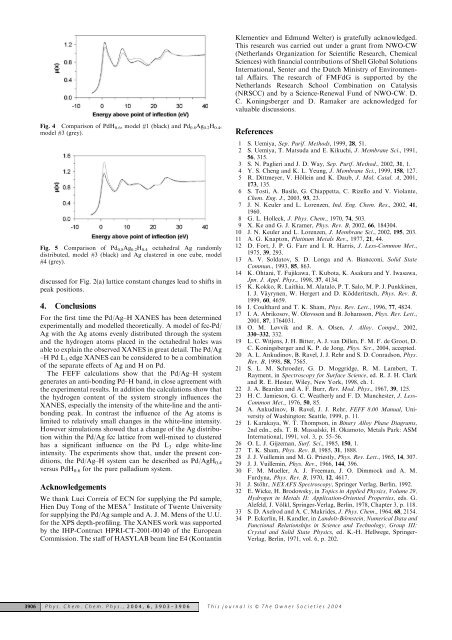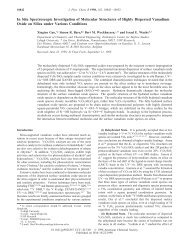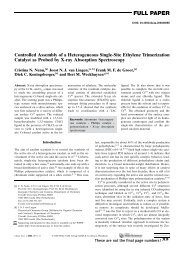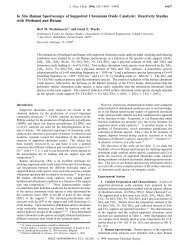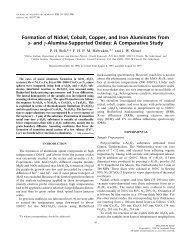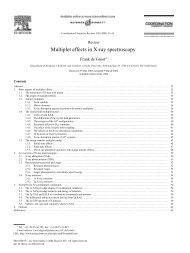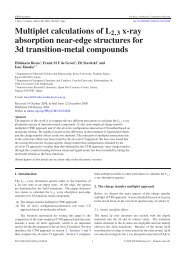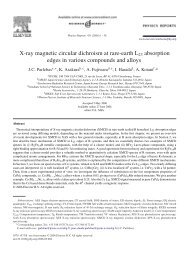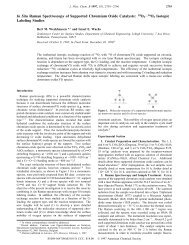PCCPwww - Inorganic Chemistry and Catalysis
PCCPwww - Inorganic Chemistry and Catalysis
PCCPwww - Inorganic Chemistry and Catalysis
You also want an ePaper? Increase the reach of your titles
YUMPU automatically turns print PDFs into web optimized ePapers that Google loves.
Klementiev <strong>and</strong> Edmund Welter) is gratefully acknowledged.<br />
This research was carried out under a grant from NWO-CW<br />
(Netherl<strong>and</strong>s Organization for Scientific Research, Chemical<br />
Sciences) with financial contributions of Shell Global Solutions<br />
International, Senter <strong>and</strong> the Dutch Ministry of Environmental<br />
Affairs. The research of FMFdG is supported by the<br />
Netherl<strong>and</strong>s Research School Combination on <strong>Catalysis</strong><br />
(NRSCC) <strong>and</strong> by a Science-Renewal Fund of NWO-CW. D.<br />
C. Koningsberger <strong>and</strong> D. Ramaker are acknowledged for<br />
valuable discussions.<br />
Fig. 4 Comparison of PdH 0.6 , model #1 (black) <strong>and</strong> Pd 0.8 Ag 0.2 H 0.4 ,<br />
model #3 (grey).<br />
Fig. 5 Comparison of Pd 0.8 Ag 0.2 H 0.4 octahedral Ag r<strong>and</strong>omly<br />
distributed, model #3 (black) <strong>and</strong> Ag clustered in one cube, model<br />
#4 (grey).<br />
discussed for Fig. 2(a) lattice constant changes lead to shifts in<br />
peak positions.<br />
4. Conclusions<br />
For the first time the Pd/Ag–H XANES has been determined<br />
experimentally <strong>and</strong> modelled theoretically. A model of fcc-Pd/<br />
Ag with the Ag atoms evenly distributed through the system<br />
<strong>and</strong> the hydrogen atoms placed in the octahedral holes was<br />
able to explain the observed XANES in great detail. The Pd/Ag<br />
–H Pd L 3 edge XANES can be considered to be a combination<br />
of the separate effects of Ag <strong>and</strong> H on Pd.<br />
The FEFF calculations show that the Pd/Ag–H system<br />
generates an anti-bonding Pd–H b<strong>and</strong>, in close agreement with<br />
the experimental results. In addition the calculations show that<br />
the hydrogen content of the system strongly influences the<br />
XANES, especially the intensity of the white-line <strong>and</strong> the antibonding<br />
peak. In contrast the influence of the Ag atoms is<br />
limited to relatively small changes in the white-line intensity.<br />
However simulations showed that a change of the Ag distribution<br />
within the Pd/Ag fcc lattice from well-mixed to clustered<br />
has a significant influence on the Pd L 3 edge white-line<br />
intensity. The experiments show that, under the present conditions,<br />
the Pd/Ag–H system can be described as Pd/AgH 0.4<br />
versus PdH 0.6 for the pure palladium system.<br />
Acknowledgements<br />
We thank Luci Correia of ECN for supplying the Pd sample,<br />
Hien Duy Tong of the MESA 1 Institute of Twente University<br />
for supplying the Pd/Ag sample <strong>and</strong> A. J. M. Mens of the U.U.<br />
for the XPS depth-profiling. The XANES work was supported<br />
by the IHP-Contract HPRI-CT-2001-00140 of the European<br />
Commission. The staff of HASYLAB beam line E4 (Kontantin<br />
References<br />
1 S. Uemiya, Sep. Purif. Methods, 1999, 28, 51.<br />
2 S. Uemiya, T. Matsuda <strong>and</strong> E. Kikuchi, J. Membrane Sci., 1991,<br />
56, 315.<br />
3 S. N. Paglieri <strong>and</strong> J. D. Way, Sep. Purif. Method., 2002, 31, 1.<br />
4 Y. S. Cheng <strong>and</strong> K. L. Yeung, J. Membrane Sci., 1999, 158, 127.<br />
5 R. Dittmeyer, V. Ho¨ llein <strong>and</strong> K. Daub, J. Mol. Catal. A, 2001,<br />
173, 135.<br />
6 S. Tosti, A. Basile, G. Chiappetta, C. Rizello <strong>and</strong> V. Violante,<br />
Chem. Eng. J., 2003, 93, 23.<br />
7 J. N. Keuler <strong>and</strong> L. Lorenzen, Ind. Eng. Chem. Res., 2002, 41,<br />
1960.<br />
8 G. L. Holleck, J. Phys. Chem., 1970, 74, 503.<br />
9 X. Ke <strong>and</strong> G. J. Kramer, Phys. Rev. B, 2002, 66, 184304.<br />
10 J. N. Keuler <strong>and</strong> L. Lorenzen, J. Membrane Sci., 2002, 195, 203.<br />
11 A. G. Knapton, Platinum Metals Rev., 1977, 21, 44.<br />
12 D. Fort, J. P. G. Farr <strong>and</strong> I. R. Harris, J. Less-Common Met.,<br />
1975, 39, 293.<br />
13 A. V. Soldatov, S. D. Longa <strong>and</strong> A. Biancconi, Solid State<br />
Commun., 1993, 85, 863.<br />
14 K. Ohtani, T. Fujikawa, T. Kubota, K. Asakura <strong>and</strong> Y. Iwasawa,<br />
Jpn. J. Appl. Phys., 1998, 37, 4134.<br />
15 K. Kokko, R. Laithia, M. Alatalo, P. T. Salo, M. P. J. Punkkinen,<br />
I. J. Väyrynen, W. Hergert <strong>and</strong> D. Ködderitzsch, Phys. Rev. B,<br />
1999, 60, 4659.<br />
16 I. Coulthard <strong>and</strong> T. K. Sham, Phys. Rev. Lett., 1996, 77, 4824.<br />
17 I. A. Abrikosov, W. Olovsson <strong>and</strong> B. Johansson, Phys. Rev. Lett.,<br />
2001, 87, 1764031.<br />
18 O. M. Løvvik <strong>and</strong> R. A. Olsen, J. Alloy. Compd., 2002,<br />
330–332, 332.<br />
19 L. C. Witjens, J. H. Bitter, A. J. van Dillen, F. M. F. de Groot, D.<br />
C. Koningsberger <strong>and</strong> K. P. de Jong, Phys. Scr., 2004, accepted.<br />
20 A. L. Ankudinov, B. Ravel, J. J. Rehr <strong>and</strong> S. D. Conradson, Phys.<br />
Rev. B, 1998, 58, 7565.<br />
21 S. L. M. Schroeder, G. D. Moggridge, R. M. Lambert, T.<br />
Rayment, in Spectroscopy for Surface Science, ed. R. J. H. Clark<br />
<strong>and</strong> R. E. Hester, Wiley, New York, 1998, ch. 1.<br />
22 J. A. Bearden <strong>and</strong> A. F. Burr, Rev. Mod. Phys., 1967, 39, 125.<br />
23 H. C. Jamieson, G. C. Weatherly <strong>and</strong> F. D. Manchester, J. Less-<br />
Common Met., 1976, 50, 85.<br />
24 A. Ankudinov, B. Ravel, J. J. Rehr, FEFF 8.00 Manual, University<br />
of Washington: Seattle, 1999, p. 11.<br />
25 I. Karakaya, W. T. Thompson, in Binary Alloy Phase Diagrams,<br />
2nd edn., eds. T. B. Massalski, H. Okamoto, Metals Park: ASM<br />
International, 1991, vol. 3, p. 55–56.<br />
26 O. L. J. Gijzeman, Surf. Sci., 1985, 150, 1.<br />
27 T. K. Sham, Phys. Rev. B, 1985, 31, 1888.<br />
28 J. J. Vuillemin <strong>and</strong> M. G. Priestly, Phys. Rev. Lett., 1965, 14, 307.<br />
29 J. J. Vuillemin, Phys. Rev., 1966, 144, 396.<br />
30 F. M. Mueller, A. J. Freeman, J. O. Dimmock <strong>and</strong> A. M.<br />
Furdyna, Phys. Rev. B, 1970, 12, 4617.<br />
31 J. Stöhr, NEXAFS Spectroscopy, Springer Verlag, Berlin, 1992.<br />
32 E. Wicke, H. Brodowsky, in Topics in Applied Physics, Volume 29,<br />
Hydrogen in Metals II: Application-Oriented Properties, eds. G.<br />
Alefeld, J. Vo¨ lkl, Springer-Verlag, Berlin, 1978, Chapter 3, p. 118.<br />
33 S. D. Axelrod <strong>and</strong> A. C. Makrides, J. Phys. Chem., 1964, 68, 2154.<br />
34 P. Eckerlin, H. K<strong>and</strong>ler, in L<strong>and</strong>olt-Bo¨rnstein, Numerical Data <strong>and</strong><br />
Functional Relationships in Science <strong>and</strong> Technology, Group III:<br />
Crystal <strong>and</strong> Solid State Physics, ed. K.-H. Hellwege, Springer-<br />
Verlag, Berlin, 1971, vol. 6, p. 202.<br />
3906 Phys. Chem. Chem. Phys., 2004, 6 , 3903–3906 This journal is & The Owner Societies 2004


